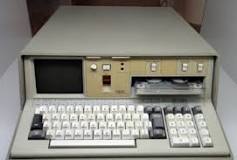The Evolution of Portable Computers: A Brief History
Portable computers, commonly known as laptops, notebooks, or ultrabooks, have become an integral part of our daily lives. These compact devices have revolutionized the way we work, communicate, and access information on the go.
One of the earliest portable computers was the Osborne 1, introduced in 1981. It weighed a hefty 24 pounds and had a tiny 5-inch display. Despite its bulkiness, it was considered revolutionary at the time as it allowed users to carry their computer with them.
Over the years, portable computers have undergone significant advancements in terms of design, performance, and portability. The introduction of lightweight materials and powerful processors has made modern laptops sleeker, faster, and more efficient than ever before.
Today, we have a wide range of portable computers to choose from – from budget-friendly Chromebooks to high-end gaming laptops. These devices come in various sizes and configurations to cater to different needs and preferences.
With features like long-lasting battery life, high-resolution displays, and fast SSD storage, portable computers have become indispensable tools for professionals, students, and casual users alike. They offer the flexibility to work or entertain oneself from anywhere without being tied down to a desk.
In conclusion, the evolution of portable computers has transformed the way we live and work in today’s digital age. As technology continues to advance rapidly, we can expect even more innovative features and designs in future generations of portable computers.
6 Essential Tips for Safeguarding Your Portable Computer
- Always use a protective case to prevent damage during transportation.
- Regularly clean the keyboard and screen to maintain hygiene.
- Avoid placing heavy objects on top of the portable computer to prevent damage.
- Use a surge protector when charging to protect against power surges.
- Ensure proper ventilation by not blocking air vents while using the computer.
- Backup important files regularly to avoid data loss in case of hardware failure.
Always use a protective case to prevent damage during transportation.
When it comes to safeguarding your portable computer during transportation, using a protective case is essential. A durable case provides an extra layer of protection against bumps, scratches, and other potential damages that can occur while on the move. By investing in a quality protective case, you can ensure that your portable computer remains safe and secure, allowing you to carry it with peace of mind wherever you go.
Regularly clean the keyboard and screen to maintain hygiene.
To ensure hygiene and longevity of your portable computer, it is essential to regularly clean the keyboard and screen. Dust, dirt, and germs can accumulate on these surfaces over time, potentially affecting your health and the device’s performance. Use a soft microfiber cloth and gentle cleaning solution to wipe down the keyboard and screen, removing any smudges or debris. By incorporating this simple maintenance tip into your routine, you can keep your portable computer clean and hygienic for optimal use.
Avoid placing heavy objects on top of the portable computer to prevent damage.
To ensure the longevity and optimal performance of your portable computer, it is crucial to avoid placing heavy objects on top of it. Excessive weight can exert pressure on the delicate components inside the device, potentially causing damage to the screen, keyboard, or internal hardware. By being mindful of this tip and handling your portable computer with care, you can maintain its functionality and appearance for years to come.
Use a surge protector when charging to protect against power surges.
When charging your portable computer, it is advisable to use a surge protector to safeguard against power surges. Power surges can occur unexpectedly and may damage your device’s sensitive components. By using a surge protector, you can help prevent potential damage and ensure a stable power supply while charging your portable computer. This simple precaution can go a long way in protecting your valuable device from electrical fluctuations and ensuring its longevity.
Ensure proper ventilation by not blocking air vents while using the computer.
To ensure optimal performance and prevent overheating, it is essential to maintain proper ventilation for your portable computer by avoiding blocking the air vents while using the device. Blocking the air vents can lead to a build-up of heat, potentially causing damage to internal components and reducing the overall lifespan of the computer. By allowing adequate airflow through the vents, you can help keep your portable computer running smoothly and efficiently for longer periods of time.
Backup important files regularly to avoid data loss in case of hardware failure.
It is crucial to back up important files regularly on your portable computer to prevent data loss in the event of hardware failure. By creating backups of your essential documents, photos, and other data on an external storage device or cloud service, you can ensure that your information remains safe and accessible even if your computer malfunctions. Implementing a consistent backup routine is a simple yet effective way to safeguard your valuable data and provide peace of mind.

